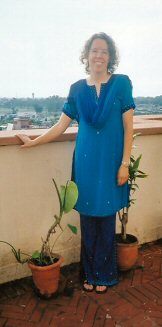No Water? India – Gurgaon Infrastructure Dilemma

Note: Water India is part of a travel blog that I wrote during an extended business trip to India. I spent two months in New Delhi as my employer implemented a new business unit in two of its call centers. In addition to my professional work, I took time to study Hindi, an effort that fostered greater co-operation and trust among my Indian business associates. It also helped me better understand the culture. We believe that language opens a gateway to understanding culture. These pages focus on my observations and experiences in India. While I was there, I practiced Walkabout Language Learning. See the list of "More India Stories" on this page to explore how culture and language intertwine.
 Showing of my new salwaar kameez.
Showing of my new salwaar kameez.Here is an interesting thing: the power goes out here at least once a day, usually a couple times a day. It is only off for about a minute before coming back on. At the guesthouse that is; at work they have a UPS - an uninterruptible power supply - to maintain power until the back up power generators kick in.
When I was talking to a Swiss lady that I met who lives on one of the buildings in our apartment complex, she said that it comes back on because there are two big generators in the apartment complex on the roof of one or two of the buildings. They kick in to provide power when the city power supply fails. If power is out for a long time, the generators have to trade off so that they can cool down.
Wow! That is different from my expectations back home. Here in Gurgaon, the governmental infrastructure is not sufficient to provide continuous power so private parties have to make provisions for themselves if they want a continuous power supply.
More India Stories
- Introduction to India Blog
- Welcome to Delhi
- Holy Cow, What Happens When One Dies?
- Visit to the Market
- Traffic in India
- Call Centers in India: Am I Talking to … Myself?
- No Water? India’s Dilemma. Power Out? No Biggie
- Indian Clothing Here and There
- Indian Music: Singing Songs and Swimming Swamp
- Whatever You Do, Don’t Spoil Your Car
- Explore the Taj Mahal in a Unique Way
- Poverty in India: A little TV Tonight? Your Tarp or Mine?
- Sweet Shops
Additionally, there is no public water. The apartment complex draws on two aquifers under the ground for the water we have. (No wonder they say "Don't drink the water" considering the infinite number of men I've seen by the roadside... when you gotta go, you gotta go...) Apparently there is no public water in India, Gurgaon where the office and my apartment are (it is a suburb of Delhi). They are running a pipe from Delhi to Gurgaon to provide water, but the project has gotten stalled because there is a railway track in the way, and the government can't decide what to do about it. Go over, under, around? It's been four years they are thinking about it. (This also according to the Swiss lady.) We don't realize the conveniences that we take for granted in the US.
Yesterday, I wore the salwar kameez that I bought at the market. It is like a long shirt with blowsy trousers. It is pretty and very feminine. There is this silk shawl thing that I wear with it, just draped over my shoulders with the ends hanging down the back. Seems not so very practical, but very feminine as it sways and swishes as I walk. About a million people told me a looked beautiful, even a few people that I didn't know. So, of course, I felt flattered by the end of the day and had a huge smile on my face. I also wore a bindi, the little black dot thingy on my forehead. It is a fashion statement. (The big red ones are for married women, but the other colors are for fashion.)
Also of interest, only 12% of people in India own cars.
--Posted by Leslie, Friday, August 22
← Previous: Call Centers in India: Am I Talking to … Myself?
Next: Indian Clothing Here and There →
Return from Water India to Language Lore
Return to Your Language Guide home
Stay in Touch with Language Lore ezine
Want to stay in touch? Subscribe to Language Lore, our internet language learning email newsletter. This free ezine facilitates your language learning journey. See our back issues here.
Go to your email now to confirmation your subscription. If you don't see an email within an hour (check your junk mail folder too), please contact us. We respect your privacy and never sell or rent our subscriber lists. If you want to get off this list later, one click unsubscribes you.
New! Comments
Have your say about what you just read! Leave me a comment in the box below.